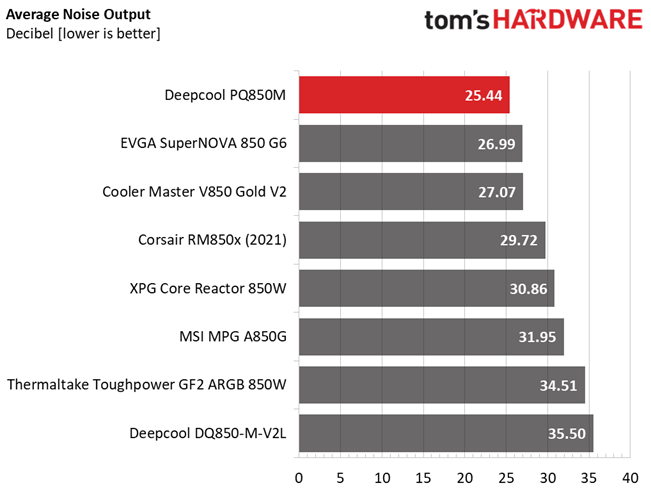Why you can trust Tom's Hardware
Performance Rating
The overall performance cannot meet the competition. The difference is not huge, though, but the second from the bottom place still doesn't look good.
Noise Rating
The graph below depicts the cooling fan's average noise over the PSU's operating range, with an ambient temperature between 30 to 32 degrees Celsius (86 to 89.6 degrees Fahrenheit).
Under normal operating temperatures, the average noise output is low and this is a major asset for the PQ850M
Efficiency Rating
The following graph shows the PSU's average efficiency throughout its operating range with an ambient temperature close to 30 degrees Celsius.
The average efficiency score is decent. It would be nice to be closer to or above 89%.
Power Factor Rating
The following graphs show the PSU's average power factor reading throughout its operating range with an ambient temperature close to 30 degrees Celsius and 115V/230V voltage input.


The APFC converter needs tuning for higher PF readings.
Get Tom's Hardware's best news and in-depth reviews, straight to your inbox.
MORE: Best Power Supplies
MORE: How We Test Power Supplies
MORE: All Power Supply Content
Current page: Performance, Noise, Efficiency and Power Factor
Prev Page Transient Response Tests, Timing Tests, Ripple Measurements and EMC Pre-Compliance Testing Next Page Bottom Line
Aris Mpitziopoulos is a contributing editor at Tom's Hardware, covering PSUs.
-
Co BIY This category seems to show all the competitors neck-and-neck. Are they all using the SeaSonic Gold Platform ?Reply
I don't mind the grid pattern and perhaps it's excellent airflow allowed for less fan.
I think it looks particularly sharp on the back. -
drajitsh It is not ideal to buy a PSU right now because we are in a transition phase from the previous ATX spec to the new one. I am likely going to be forced to buy 2 systems for my office. They will have integrated graphics to start with and will be upgraded to low end discrete graphics in 1-2 years. Does your recommendation still stand?Reply -
Co BIY Replydrajitsh said:It is not ideal to buy a PSU right now because we are in a transition phase from the previous ATX spec to the new one. I am likely going to be forced to buy 2 systems for my office. They will have integrated graphics to start with and will be upgraded to low end discrete graphics in 1-2 years. Does your recommendation still stand?
I don't think low end cards will be requiring the new connectors in the short term. This is a necessity only for the high end cards with crazy peak power draws.
The makers of the low end cards will also build them to match the likely customer , you and the other 500 million people running machines without the ATX3.0 PSU upgrades.
Question: Why are PSU's built with fan grills ? None of the other fans in PCs have grills and PSU fans aren't bigger or faster . Also readily replaceable fans could be a great selling point because users want to mod. -
Co BIY ReplyTom Sunday said:The old story...eveyone wants a piece of the pie! Deepcool once dedicated exclusively for PC cooling now into PSU's as well. Next we have Seasonic making memory. I wish that companies would perfect their originally intended product line and giving us those results, instead of just plastering their nane on products made by others. I have no respect for this as it is a quick fix to make more money and even having some people believe that they have a better product when this is absolutely not the case .
I agree with you if they just slap their "Premium" name and a few RGB's to something of below average quality and then throw it out there at a Premium price.
In this case they started with a very solid platform, executed it competently and it delivers the goods quietly.
This PSU doesn't seem like it's worth getting the pitchforks out for. -
Co BIY ReplyTom Sunday said:Yes you are on the point as always!
Thank You for the compliment!
Tom Sunday said:My other 'Deepcool' thought and great hope was that someday perhaps air-cooling products will equal the thermal performance of AIO’s. In part many users even with extensive experience sometimes have trouble installing AIO’s into their case.
I agree with you that the simplicity, reliability and cost advantages of air cooling justify continued development. Lenovo has an interesting offset stacked air cooler design on their new Threadripper workstations that I would like to see make it to the DIY market .
Lenovo Thinkstation P620 Review (at Anandtech)


